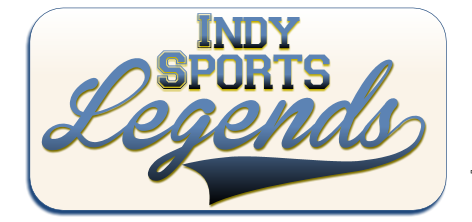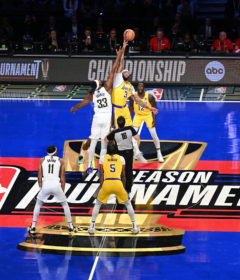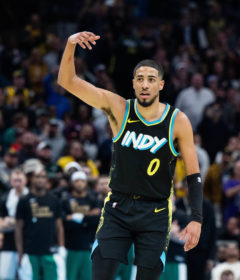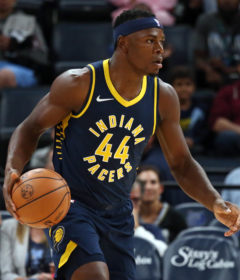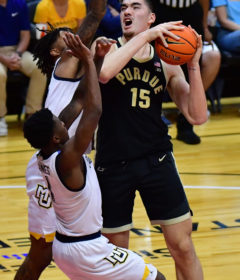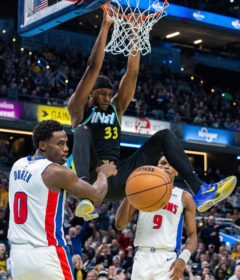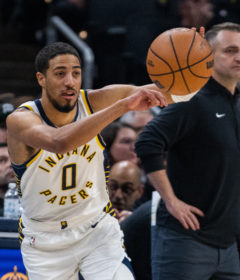Dragash: Should NBA take a page from MLB draft format?

By CRAIG DRAGASH
ISL Correspondent
OK, I know it’s summertime, but you’re about to take a quiz; don’t worry, it’s only one question:

What do Giannis Antetokounmpo, Lucas Noguiera, Sergey Karasev, Livio Jean-Charles, and Nemenja Nedovic all have in common?
A. they are all ambassadors for their respective countries
B. they are all world cup soccer players
C. they are all first round NBA draft picks
If you’re like me, “C” would have been your last choice prior to this year’s NBA draft, but “C” is indeed the correct answer. The NBA draft has gone from a “who’s who” among top amateur basketball talent to a “who’s that????”. The fact that Anthony Bennett, who’s name is not nearly as recognizable as a Nerlens Noel, Victor Oladipo, or Otto Porter, suggests that the days of watching the better college basketball players in the NCAA tournament move on to the draft a few months later are a thing of the past.
So here’s another question (not for a grade): Is this a good thing?
I can remember when Michael Jordan was drafted in 1984 by the Chicago Bulls, my favorite NBA team growing up. The reason why I remember that is because the memory of his North Carolina Tar Heels defeating Georgetown with Jordan’s baseline jumper with 17 seconds left, coupled with Fred Brown’s ill-advised pass to James Worthy that sealed the victory, was still fresh in my mind. Yes, that was the year prior to the draft, but that moment is still played on tournament highlight shows today, and will be for years to come. And he was selected two picks after Hakeem Olajuwon of Houston, who obtained legend status during NCAA tournament playwith “Phi Slamma Jamma”.
The 1988 draft produced Danny Manning of Kansas as its first pick; Manning was thought of as one of the greatest college players of all time after leaving as the Jayhawks’ all-time leading scorer. Yes, Manning’s NBA career certainly didn’t match what he did in college, but there was no surprise when he was selected by the Los Angeles Clippers as their top pick. Larry Johnson of UNLV was the first pick in 1991, followed by Kenny Anderson, Billy Owens, Dikembe Mutombo, and Steve Smith, all who played in the 1991 NCAA tournament. Owens was remembered as being on the Syracuse team that was knocked out by 15th-seeded Richmond in the first round. Again, all names that are recognizable because of their contributions during their college careers.
Fast forward to 2005, when David Stern brought a new rule into the NBA’s collective bargaining agreement (CBA) that said in order to be eligible for the draft, a player must be 19 years of age during the year of the draft. So coming out of high school, a player needed to either compete for at least one year in college, play in the NBA’s Developmental League (D-League), or play overseas for at least one year before becoming eligible. The landscape of the draft went through a progressive change over the next few years.
The 2006 draft saw Andrea Bargnani from Italy become its first pick under the new CBA. After Bargnani, more players taken in the first round were recognizable to a knowledgeable fan than those who weren’t, based on where they played their college ball. The next two years saw more of the same, then in 2009, the middle of the first round, names like Victor Claver of Spain, Omri Casspi of Israel, and Rodrigue Beaubois of France came off the board. In 2011, Jonas Valanciunas, Jan Vesely, and Bismack Biyombo went 5th, 6th, and 7th respectively.
Another question regarding those names: where are they now?
It seems as though NBA general managers are looking more at seasoned talent coming from teams that play overseas over younger players that would be drafted more on potential than proven ability. Problem is, many of these names are not appearing in the programs, media guides, or box scores of the teams that are drafting them.
Which begs this question: is NCAA baseball doing it right?
Players who graduate high school are immediately eligible for the Major League Baseball draft, but they have a choice: sign with the team that drafted you, go play college baseball for at least three years, or play for a junior college for at least a year. The top pick in the 2013 draft was Mark Appel, a right handed pitcher from Stanford, who was drafted after his senior year by the Houston Astros. He was praised by commissioner Bud Selig, who compared him and previous Astros #1 pick Carlos Correa as the next Craig Biggio and Jeff Bagwell for the Astros’ future. Appel was drafted by the Pittsburgh Pirates at number 8 the previous year.
Would Selig say this about someone who was drafted after one year of college baseball? I think not.
Let’s use the Indiana Hoosiers’ 2013 baseball team as an example of what could have happened if Major League Baseball allowed players to be drafted after their freshman year of college. The nucleus of the team that made its run to this year’s College World Series consisted of designated hitter Scott Donley, first baseman Sam Travis, catcher Kyle Schwarber, and starting pitcher Aaron Slegers, all sophomores; along with pitchers Joey Denato and Ryan Halstead, third baseman Dustin DeMuth, and outfielder Casey Smith, who were juniors.
Where would the Hoosiers have been without those players?
Bonus question: Did that exposure lead to a better draft position for those players?
That question is the one I would propose to incoming NBA commissioner Adam Silver. In addition, I would ask if players are getting too much bad advice coming out of college and seeing their playing careers basically eliminated as a result? All I know is that I watched my share of college basketball this year, and when I saw the names coming out of the NBA draft last week, I found myself asking similar questions to those mentioned above.
I’m not suggesting the NBA adopt a rule that matches that of Major League Baseball, but I think there is something to be said for either being ready to play coming out of college, or needing some time to blossom into a player that can have at least a productive NBA career. LeBron James had no need to play basketball in college. Neither did Kobe Bryant. But those types of talents are so rare that it seems as though something needs to be done to be sure that these players are taking the proper path to their ultimate career goal. The latest name to be a can’t-miss prospect is Andrew Wiggins, who will be a freshman at Kansas this season. Many say he could play in the league right now. Kansas coach Bill Self fully acknowledges that Wiggins is likely to be a “one-and-done” player. Should he be allowed to pursue his dreams at the age of 18?
These questions certainly can generate a great deal of debate. I just miss the days of the NBA draft where I actually knew who was being drafted, and I was either excited about what those players could do for their teams, or I scratched my head and said “huh?” Now, there are so many who are drafted that neither reaction would apply.
Antetokounmpo, Noguiera, Karasev, Jean-Charles, Nedovic? All first round picks, all not likely to be on NBA rosters this season.
Should Adam Silver and Bud Selig have lunch soon?
Follow Craig Dragash on Twitter: www.twitter.com/cdragash_isl.
Follow Indy Sports Legends on Twitter: www.twitter.com/cliffbrunt_isl.
